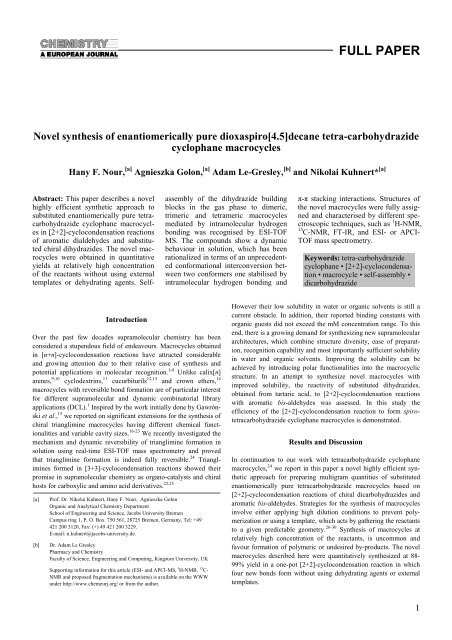The Development of Novel Antibiotics Using ... - Jacobs University
The Development of Novel Antibiotics Using ... - Jacobs University
The Development of Novel Antibiotics Using ... - Jacobs University
Create successful ePaper yourself
Turn your PDF publications into a flip-book with our unique Google optimized e-Paper software.
FULL PAPER<br />
<strong>Novel</strong> synthesis <strong>of</strong> enantiomerically pure dioxaspiro[4.5]decane tetra-carbohydrazide<br />
cyclophane macrocycles<br />
Hany F. Nour, [a] Agnieszka Golon, [a] Adam Le-Gresley, [b] and Nikolai Kuhnert* [a]<br />
Abstract: This paper describes a novel<br />
highly efficient synthetic approach to<br />
substituted enantiomerically pure tetracarbohydrazide<br />
cyclophane macrocycles<br />
in [2+2]-cyclocondensation reactions<br />
<strong>of</strong> aromatic dialdehydes and substituted<br />
chiral dihydrazides. <strong>The</strong> novel macrocycles<br />
were obtained in quantitative<br />
yields at relatively high concentration<br />
<strong>of</strong> the reactants without using external<br />
templates or dehydrating agents. Selfassembly<br />
<strong>of</strong> the dihydrazide building<br />
blocks in the gas phase to dimeric,<br />
trimeric and tetrameric macrocycles<br />
mediated by intramolecular hydrogen<br />
bonding was recognised by ESI-TOF<br />
MS. <strong>The</strong> compounds show a dynamic<br />
behaviour in solution, which has been<br />
rationalized in terms <strong>of</strong> an unprecedented<br />
conformational interconversion between<br />
two conformers one stabilised by<br />
intramolecular hydrogen bonding and<br />
π-π stacking interactions. Structures <strong>of</strong><br />
the novel macrocycles were fully assigned<br />
and characterised by different spectroscopic<br />
techniques, such as 1 H-NMR,<br />
13 C-NMR, FT-IR, and ESI- or APCI-<br />
TOF mass spectrometry.<br />
Keywords: tetra-carbohydrazide<br />
cyclophane • [2+2]-cyclocondensation<br />
• macrocycle • self-assembly •<br />
dicarbohydrazide<br />
[a]<br />
[b]<br />
Introduction<br />
Over the past few decades supramolecular chemistry has been<br />
considered a stupendous field <strong>of</strong> endeavours. Macrocycles obtained<br />
in [n+n]-cyclocondensation reactions have attracted considerable<br />
and growing attention due to their relative ease <strong>of</strong> synthesis and<br />
potential applications in molecular recognition. 1-8 Unlike calix[n]<br />
arenes, 9,10 cyclodextrins, 11 cucurbiturils 12,13 and crown ethers, 14<br />
macrocycles with reversible bond formation are <strong>of</strong> particular interest<br />
for different supramolecular and dynamic combinatorial library<br />
applications (DCL). 1 Inspired by the work initially done by Gawrónski<br />
et al., 15 we reported on significant extensions for the synthesis <strong>of</strong><br />
chiral trianglimine macrocycles having different chemical functionalities<br />
and variable cavity sizes. 16-23 We recently investigated the<br />
mechanism and dynamic reversibility <strong>of</strong> trianglimine formation in<br />
solution using real-time ESI-TOF mass spectrometry and proved<br />
that trianglimine formation is indeed fully reversible. 24 Trianglimines<br />
formed in [3+3]-cyclocondensation reactions showed their<br />
promise in supramolecular chemistry as organo-catalysts and chiral<br />
hosts for carboxylic and amino acid derivatives. 22,25<br />
Pr<strong>of</strong>. Dr. Nikolai Kuhnert, Hany F. Nour, Agnieszka Golon<br />
Organic and Analytical Chemistry Department<br />
School <strong>of</strong> Engineering and Science, <strong>Jacobs</strong> <strong>University</strong> Bremen<br />
Campus ring 1, P. O. Box. 750 561, 28725 Bremen, Germany, Tel: +49<br />
421 200 3120, Fax: (+) 49 421 200 3229.<br />
E-mail: n.kuhnert@jacobs-university.de.<br />
Dr. Adam Le Gresley<br />
Pharmacy and Chemistry<br />
Faculty <strong>of</strong> Science, Engineering and Computing, Kingston <strong>University</strong>, UK<br />
Supporting information for this article (ESI- and APCI-MS, 1 H-NMR, 13 C-<br />
NMR and proposed fragmentation mechanisms) is available on the WWW<br />
under http://www.chemeurj.org/ or from the author.<br />
However their low solubility in water or organic solvents is still a<br />
current obstacle. In addition, their reported binding constants with<br />
organic guests did not exceed the mM concentration range. To this<br />
end, there is a growing demand for synthesizing new supramolecular<br />
architectures, which combine structure diversity, ease <strong>of</strong> preparation,<br />
recognition capability and most importantly sufficient solubility<br />
in water and organic solvents. Improving the solubility can be<br />
achieved by introducing polar functionalities into the macrocyclic<br />
structure. In an attempt to synthesize novel macrocycles with<br />
improved solubility, the reactivity <strong>of</strong> substituted dihydrazides,<br />
obtained from tartaric acid, to [2+2]-cyclocondensation reactions<br />
with aromatic bis-aldehydes was assessed. In this study the<br />
efficiency <strong>of</strong> the [2+2]-cyclocondensation reaction to form spirotetracarbohydrazide<br />
cyclophane macrocycles is demonstrated.<br />
Results and Discussion<br />
In continuation to our work with tetracarbohydrazide cyclophane<br />
macrocycles, 24 we report in this paper a novel highly efficient synthetic<br />
approach for preparing multigram quantities <strong>of</strong> substituted<br />
enantiomerically pure tetracarbohydrazide macrocycles based on<br />
[2+2]-cyclocondensation reactions <strong>of</strong> chiral dicarbohydrazides and<br />
aromatic bis-aldehydes. Strategies for the synthesis <strong>of</strong> macrocycles<br />
involve either applying high dilution conditions to prevent polymerization<br />
or using a template, which acts by gathering the reactants<br />
to a given predictable geometry. 26-30 Synthesis <strong>of</strong> macrocycles at<br />
relatively high concentration <strong>of</strong> the reactants, is uncommon and<br />
favour formation <strong>of</strong> polymeric or undesired by-products. <strong>The</strong> novel<br />
macrocycles described here were quantitatively synthesized at 88-<br />
99% yield in a one-pot [2+2]-cyclocondensation reaction in which<br />
four new bonds form without using dehydrating agents or external<br />
templates.<br />
1

















